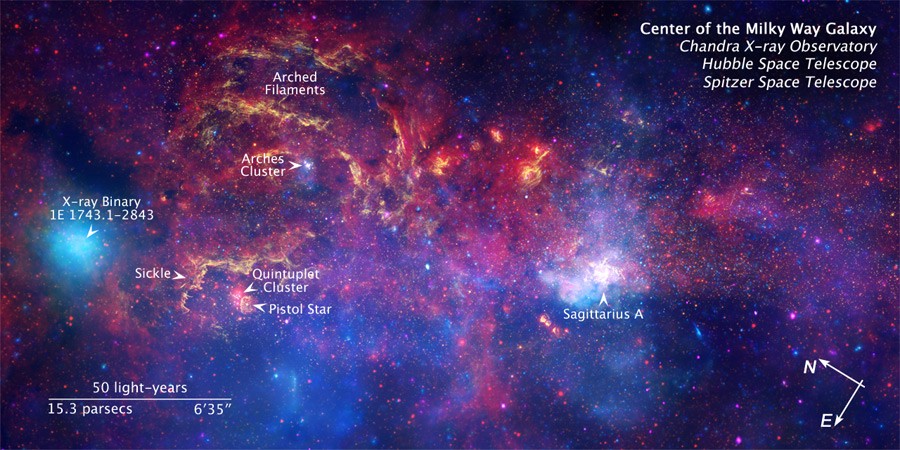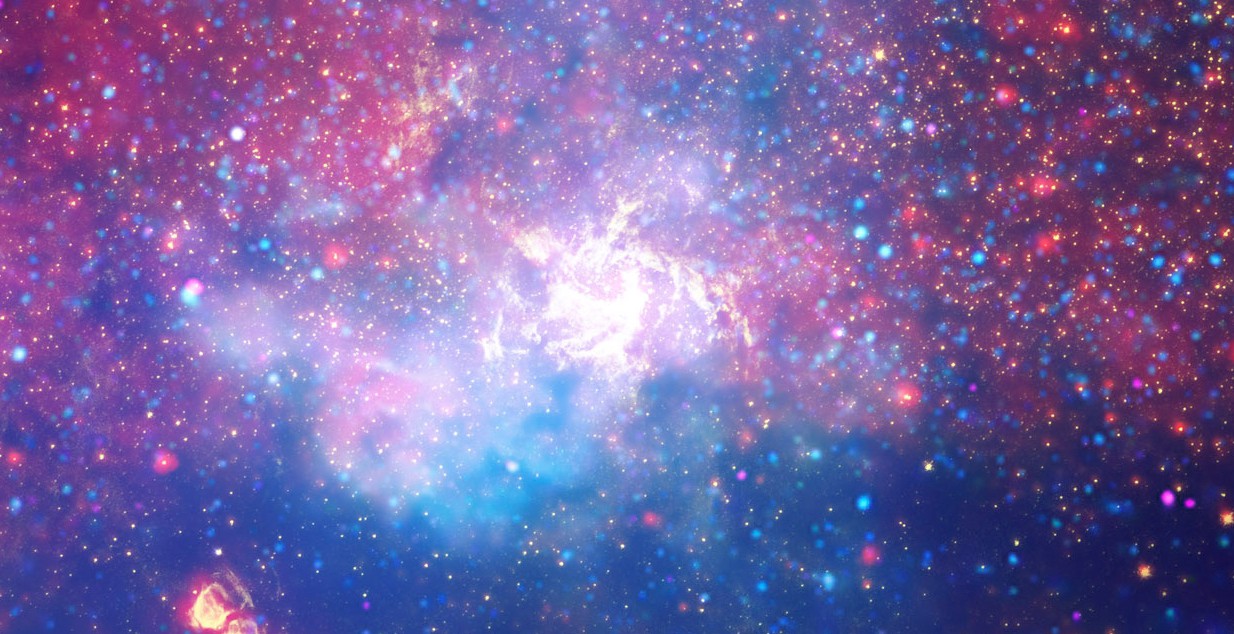Ask Ethan No. 28: How to Feed a Monster
- Transfer
We like all these amazing stories. Imagination helps bring to life the heroes of these stories.
- Daniel Tammet
The reader asks:
Recently it became known that Sagittarius A * will meet with a cloud of gas this year, and it is likely that it will turn into a quasar.
I think not, because of its size - but I don’t know how to prove it reasonably without being an astrophysicist. Tell me, Ethan, will all of us end when high-energy rays run along almost the entire electromagnetic spectrum in all directions, together with relativistic jets?
Wiki Explanation : Sagittarius A * (Latin Sagittarius A *, Sgr A *; pronounced "Sagittarius A with an asterisk" - a compact radio source located in the center of our galaxy is a part of the radio source Sagittarius A. Also emits in infrared, x-ray and other . Represents ranges supermassive object (probably a black hole), surrounded by the hot gas cloud leaky diameter of about 1.8 pc distance to the radio source is about 26 thousand light-years, a central object mass -... 4.3 x 10 6 sun.
For start consider what we have st.

This is a view of the center of our galaxy, compiled by superimposing several images obtained in different ranges, including x-rays, visible and infrared light. The very center of the galaxy is the most densely populated place of all that we can find in a million light-years from either side of us. Below, I maximized the center of the galaxy in the picture.

If we consider only the stars and their motion, we can make an important conclusion about gravity at this point in space - the stars move in closed elliptical orbits (in three dimensions), around a certain center.

And no light comes from this center, but judging by the movements of the stars, there must be at least 4 million solar masses there. Today, this object is known as Sagittarius A *, a supermassive black hole in the center of the Milky Way, and the most massive object in our galaxy.
Everything becomes even more interesting if we look not only at the stars, but also at other objects - for example, gas and dust clouds.

As expected, in any galaxy you can find gas clouds of any kind - molecular, ionized, compressible, stationary, high-speed, etc. All of them can be found in the center and our galaxy. In this sense, the center is no different from other places in the galaxy.
But in the center there is another difference - there is a body with a mass of 4 million solar cells, and this is the closest to us from such large objects, located only 25,000-27,000 light-years from us.

Using various instruments at the disposal of the Very Large Telescope in Chile, we tracked some clouds in the center of the galaxy, looking for objects that pass near the ultramassive center.

This is of interest to us because any relatively small object that passes near a massive one will be torn to shreds, heated and begin to fall to the center with acceleration. This is true even for our boring solar system, where we saw the result of a comet meeting a massive planet. In 1994, the comet Shoemaker-Levy was torn apart by Jupiter, and fell to the planet, presenting an excellent sight for amateurs and professionals in astronomy.

But if some object encounters a black hole, its atoms get so hot that they turn into ions - they decay into a positively charged nucleus and free electrons. And since black holes, in addition to large masses, also have strong magnetic fields, these particles will begin to accelerate greatly, which will lead to enormous energy emissions.

These phenomena occur everywhere in the Universe - both in nearby galaxies like Centauri A and in distant quasars.
What about the center of our galaxy? None of the stars is going to collide with an ultra-massive object, and the flashes visible on x-ray and infrared images were small and not impressive. So, our black hole is practically not fed.
But everything can change.

The high-speed gas cloud, first noted in 2002, has already accelerated twice as much as the original speed, and is now flying at a speed of about 2000 km / s (about 1% of the speed of light). It will take place at only 3100 radius of the event horizon from the black hole. The picture shows that in 2011 the cloud has already begun to change shape, and its temperature rises to 600 K!
Scientists have already simulated what we need to expect in the coming years - and this must be seen:
But no matter how wonderful this event is - and from a scientific point of view, it will give us a lot of information about the center of our galaxy and about the dynamic processes occurring near black holes - this is not the catastrophe that the most impressionable citizens are waiting for.
Firstly, this cloud weighs only several times more than the Earth - this is clearly not enough for a large energy surge. Secondly, the distance of 3100 radiuses of the event horizon is by no means small; for our black hole, the distance the cloud approaches it will be ten times greater than the distance from the Sun to Pluto. Thirdly, a gas that will directly contact a black hole will get to it for decades.

All black holes should have an accretion disk built from matter that was torn apart by gravity and concentrated around it. On this occasion, we will also receive a lot of information when we see how a gas cloud interacts with our black hole. In addition, we will be able to catch a certain amount of x-ray from an accelerating hot gas, which will also replenish our knowledge of the center of the galaxy.
The most interesting will begin in 2018. Remember that animation about moving around the center of the galaxy? I will bring it again, just now pay attention to the star SO-2.

In 2018, it will pass much closer to the center of the galaxy than a gas cloud, and it will have to interact with this cloud and pass through the gas, which will be attracted by a black hole. At this moment, we can verify both the general theory of relativity and some of the provisions of astrophysics of interstellar gas.
This is a great find for science, and we will be able to learn a lot of things about how our Universe works in fairly extreme conditions. But for lovers of the end of the world, this is a bad candidate. At best, they will receive a small burst of x-ray radiation, but most of the rays will be directed perpendicular to the plane of the galaxy, and not in our direction.
